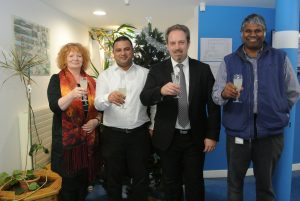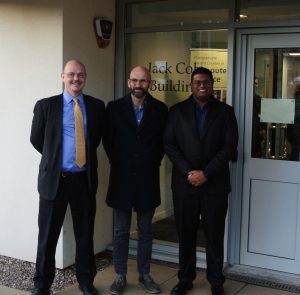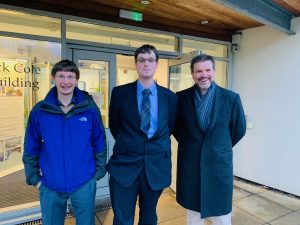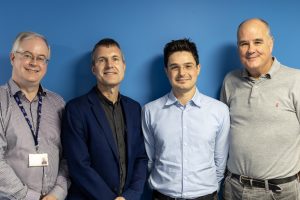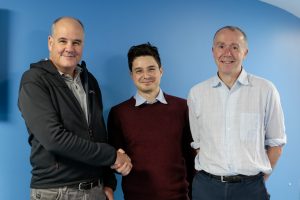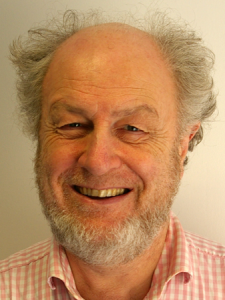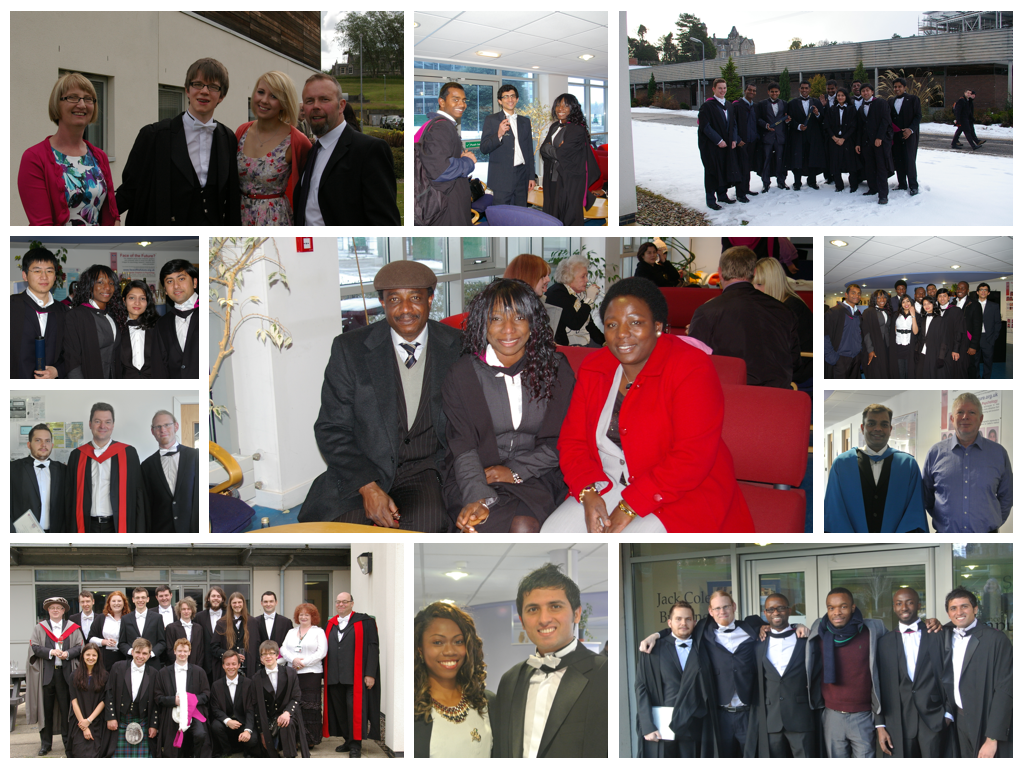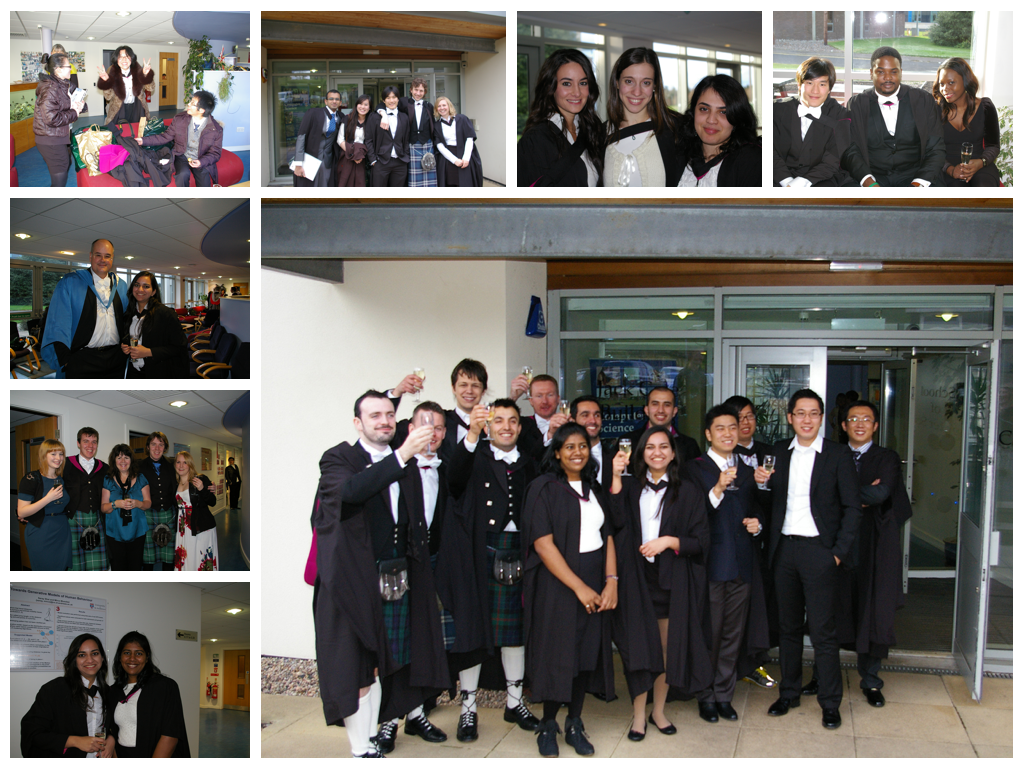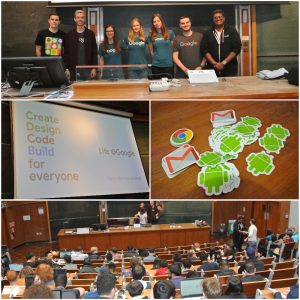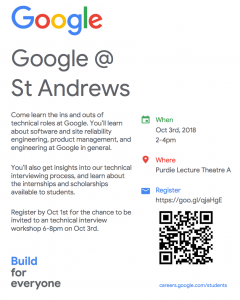Congratulations to Khawar Shehzad, who successfully defended his thesis today. He is pictured with supervisor Professor Saleem Bhatti, Internal examiner Dr Ishbel Duncan and external examiner Dr Dimitrios Pezaros, from the University of Glasgow.
News
PhD viva success: Shyam Reyal
Congratulations to Shyam Reyal, who successfully defended his thesis yesterday. He is pictured with Internal examiner Dr Tom Kelsey and external examiner Dr Mark Dunlop , from the University of Strathclyde. Shyam’s research was supervised by Dr Per Ola Kristensson and Dr Mark-Jan Nederhof.
Image courtesy of Annemarie Paton
PhD viva success: Julian Petford
Congratulations to Julian Petford, who successfully defended his thesis today. He is pictured with internal examiner Professor Aaron Quigley and external examiner Dr Jason Alexander, from Lancaster University. Julian’s PhD research in Full Coverage Displays for Non-Immersive Applications was supervised by Dr Miguel Nacenta.
Image courtesy of Wendy Boyter
PhD viva success: Simone Conte
Congratulations to Simone Conte, who successfully defended his thesis yesterday. He is pictured with supervisors Professor Al Dearle and Dr Graham Kirby, Internal examiner Professor Simon Dobson and external examiner Professor Paul Watson, from Newcastle University.
Images courtesy of Ryo Yanagida
Dr Roy Dyckhoff: A Eulogy
A Service of Thanksgiving was held at St Salvator’s Chapel on Saturday in memory of Roy Dyckhoff who died in hospital in September. The service included a eulogy composed and delivered by Head of School Professor Simon Dobson.
Since his death I’ve been fascinated to hear how others saw Roy — and how their views differed noticeably from what I saw in him. My perception was of a mathematician who’d made his home in computer science, at the computational end of our shared disciplines: someone fascinated by notions of proof as applied to computation, with a far broader and deeper mathematical knowledge than most of his colleagues and an ability to point out links between the practical and the theoretical. But in recent months I’ve learned of many different Roys: the one who moved from topology to category theory in his PhD; the one who worked on proof theory; the one who was a mainstay of computational logic in the UK; the one who rang bells here in our beautiful chapel; who climbed mountains; who studied languages — and probably many others that I’ll learn more of over the course of today.
Roy started at programming early: a one-year job with punched cards before going up to Cambridge as a maths undergraduate. And while doing his degree he spent his second year — when for some reason he had no maths exams — attending all the lectures, tutorials, and seminars for a degree in Persian. (As one does.) Perhaps this should have been a hint there that maths was only ever going to be a part of his intellectual career; or perhaps it was an early signature of an individual with exceptionally wide-ranging interests, who would constantly return to pure maths from lengthy diversions into other subjects. One look at the bookshelves of his house in St Andrews tells you this — volumes on renaissance art, arts and crafts, world history, and early music sitting alongside the algebra and number theory. It’s interesting also to look at theses of his nine PhD students, interesting how many of them sit at interfaces: between proof theory and category theory, between logic and search, between logic programming, functional programming, and type theory.
But such a broad base of interests sat on a bedrock of fascination for precision — indeed, a demand for precision, and an irritation that other people and organisations seemed so unreasonably comfortable with anything less than precise approaches to subjects. We saw this clearly in Roy’s (repeated) attempts to translate some or other aspect of the university’s regulations into first-order logic — an activity with which he persisted in the face of almost complete bafflement on the part of those to whom he addressed his memoranda. “Let S be the set of all students, and consider a set M of modules operated on by a collection of groups G-sub-i such that…” and so on. I’ve sometimes wondered how those on the receiving end felt about this mathematician’s take on their job — or indeed whether Roy himself imagined the university’s administration to be populated entirely by frustrated logicians, trapped in an imprecise world of programme requirements and module anti-requisites, and as anxious as him to re-write the rules with precision.
Given all this, I think it’s hard to assess what Roy’s influence has been, since it’s been spread over so many disparate areas — and that’s probably a good thing. “Activity is the enemy of thought,” as Christopher Strachey once observed, and the attempt to measure and quantify thought isn’t far behind. It’s not bad in itself, but we now know it breeds a narrow specialisation that over-values increasingly deep looks at increasingly tiny areas of knowledge, and systematically under-values those who want, and feel able, to contribute more widely — as Roy did. If there’s anything to take away from his career, I think it would be this, an example of scholarship that is at once broad, deep, intellectually honest, and constantly curious.
For those who’d like to mark his passing in some way, the family have suggested giving blood as a suitable marker. Alternatively, they are collecting for the Scottish Mountain Bothies Association, which was a charity he supported for many years. https://mydonate.bt.com/fundraisers/roydyckhoff
Graduation Reception: December 2018
The School will celebrate more student successes and accomplishments next month, when our MSc and PhD students graduate. We look forward to toasting their success at our graduation reception in the School of Computer Science, on Thursday 6th December, between 1.30 and 3.30. Over the years graduation has involved cakes, fizz, laughter, changeable weather and lots of reminiscing as pictured below. For family and friends who can’t make it to the graduation, the University broadcasts each graduation ceremony live.
PhD Success: Haifa Al Nasseri
Haifa Al Nasseri passed her PhD viva this week, subject to minor corrections.
Her research was on detecting data leakage in cloud virtual network isolation.
Pictured are the internal examiner, Dr Graham Kirby, Haifa Al Nasseri,
the external examiner Dr Naghmeh Moradpoor from Napier, and
her research supervisor, Dr Ishbel Duncan.
Distinguished Speaker Program Tour (Indonesia): Professor Aaron Quigley
 Professor Quigley will engage in a lecture tour to three cities in Indonesia in March 2019 as part of the Distinguished Speaker Program (DSP) of the Association for Computing Machinery (ACM). The DSP brings together international thought leaders from academia, industry, and government.
Professor Quigley will engage in a lecture tour to three cities in Indonesia in March 2019 as part of the Distinguished Speaker Program (DSP) of the Association for Computing Machinery (ACM). The DSP brings together international thought leaders from academia, industry, and government.
Professor Quigley will speak at the 5th International HCI and UX Conference which will travel to Jakarta, Surabaya and Denpasar. He will present talks on Discreet Computing and Global Human Computer Interaction along with meeting with local academic and industry leaders in Human Computer Interaction. Professor Quigley will be on sabbatical in the National University of Singapore next year.
St Andrews Research Open-day in Computer Science
Register for St Andrews ROCS HERE for free.
St Andrews ROCS is an event for those of you who engage (or are planning to engage) with research in the School of Computer Science at the University of St Andrews.
The main audiences are prospective postgraduate students, prospective or current industrial collaborators, and colleagues from other disciplines or Schools in Scotland and beyond.
The event will take place Friday October 26th 2018, between 10:00 AM and 4 PM.
There will be talks from all research groups, posters, demonstrations, guided tours, and much more.
You can learn about how to become a St Andrews PhD student or an active industrial collaborator.
The event will take place in the JACK COLE BUILDING, NORTH HAUGH, UNIVERSITY OF ST ANDREWS, ST ANDREWS, KY16 9SX, SCOTLAND.
You can download the programme of activities.
If you have any questions, e-mail dopgr-cs@st-andrews.ac.uk.
Register for St Andrews ROCS HERE for free.
Event details
- When: 26th October 2018 10:00 - 16:00
- Where: School of Computer Science
- Format: Conference, Symposium, Visiting Day
Google@Computer Science 2018
The School hosted another successful Google event today. Students heard first hand from Exie Huntington University Programs Specialist, three of our talented alumni (James Smith, Peter Josling and Blair Fyffe) and had an opportunity to chat with current students (Silvia Nepšinská, Diyana Petrova, Daria Savanovich and Shyam Reyal) who have completed internships with Goggle. The well-received and very well attended session heard about their academic background, working at Google and technical roles. A technical interview workshop will take place later this evening.


